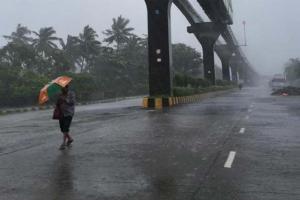According to the IMD, the normal 88 cm rain occurs between June 1 and September 30 and accounts for 75 per cent of rain in the country

This picture has been used for representational purpose only
The India Meteorological Department (IMD), here on Monday, reiterated that the country would receive normal monsoon in June-September and the conditions were favourable for good monsoon.
The India Meteorological Department (@Indiametdept), on Monday, reiterated that the country would receive normal monsoon in June-September and the conditions were favourable for good #monsoon. pic.twitter.com/Fn9JvfxmjT
— IANS Tweets (@ians_india) June 1, 2020
ADVERTISEMENT
Addressing the media, Madhavan Nair Rajeevan, Secretary in the Ministry of Earth Sciences, said, "The good news is that we will have a normal monsoon. As per the statistical model forecast, the quantitative monsoon will be 102 per cent of the long period average (LPA). The conditions are becoming favourable for good monsoon."
Madhavan Nair Rajeevan, Secretary in @moesgoi said,"The good news is that we will have a normal monsoon. As per the statistical model forecast, the quantitative monsoon will be 102% of the long period average. The conditions are becoming favourable for good monsoon." pic.twitter.com/Xls1IdK17X
— IANS Tweets (@ians_india) June 1, 2020
The IMD issues operational forecast for the south-west monsoon season in two stages --first in April and then in June. The LPA of the monsoon season rain between 1951 and 2000 is 89 cm. It's kept as a benchmark while forecasting the quantitative monsoon rain every year. According to the IMD, the normal 88 cm rain occurs between June 1 and September 30 and accounts for 75 per cent of rain in the country.
On April 15, the IMD had forecast normal monsoon at 100 per cent of LPA. The current percentage is two points extra than what the weather bureau had expected. For July rainfall, crucial for agriculture, the monsoon at 103 per cent of LPA is expected. In August, the rainfall will be little less than normal at 97 per cent, with model error of 9 per cent.
Regionwise, the northwest India is expected to receive 107 per cent, central India 103 per cent and the southern peninsula 102 per cent rain of the LPA. "We are expecting a little less than normal rain over northeast India at 96 per cent.
The northeast India has been witnessing low rainfall over the last few years with an error of 8 per cent," said the Secretary. There would be less rainfall in West Bengal and Jharkhand, he added. A colder El Nino Southern Oscillation (ENSO) and weak La Nina conditions during the monsoon season would ensure good rainfall in June-September.
"As per the probability distribution model, the probability for normal rain is 41 per cent and the deficient rain is 5 per cent. It means there is very less probability of the monsoon being on the deficient side. Below normal is 15 per cent, above normal 25 per cent, excess 14 per cent," Rajeevan said.
The distribution was more skewed towards the positive side, thus more probability for normal and above normal rain, he said. Meanwhile, the monsoon hit Kerala on Monday, marking the start of the four-month rainy season.
Advance of the southwest monsoon over the mainland is marked by its onset over Kerala and is an important indicator characterizing the transition from hot and dry season to rainy season.
Catch up on all the latest Crime, National, International and Hatke news here. Also download the new mid-day Android and iOS apps to get latest updates.
Mid-Day is now on Telegram. Click here to join our channel (@middayinfomedialtd) and stay updated with the latest news
This story has been sourced from a third party syndicated feed, agencies. Mid-day accepts no responsibility or liability for its dependability, trustworthiness, reliability and data of the text. Mid-day management/mid-day.com reserves the sole right to alter, delete or remove (without notice) the content in its absolute discretion for any reason whatsoever
 Subscribe today by clicking the link and stay updated with the latest news!" Click here!
Subscribe today by clicking the link and stay updated with the latest news!" Click here!







